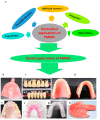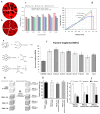Prosthodontic Applications of Polymethyl Methacrylate (PMMA): An Update
- PMID: 33049984
- PMCID: PMC7599472
- DOI: 10.3390/polym12102299
Prosthodontic Applications of Polymethyl Methacrylate (PMMA): An Update
Abstract
A wide range of polymers are commonly used for various applications in prosthodontics. Polymethyl methacrylate (PMMA) is commonly used for prosthetic dental applications, including the fabrication of artificial teeth, denture bases, dentures, obturators, orthodontic retainers, temporary or provisional crowns, and for the repair of dental prostheses. Additional dental applications of PMMA include occlusal splints, printed or milled casts, dies for treatment planning, and the embedding of tooth specimens for research purposes. The unique properties of PMMA, such as its low density, aesthetics, cost-effectiveness, ease of manipulation, and tailorable physical and mechanical properties, make it a suitable and popular biomaterial for these dental applications. To further improve the properties (thermal properties, water sorption, solubility, impact strength, flexural strength) of PMMA, several chemical modifications and mechanical reinforcement techniques using various types of fibers, nanoparticles, and nanotubes have been reported recently. The present article comprehensively reviews various aspects and properties of PMMA biomaterials, mainly for prosthodontic applications. In addition, recent updates and modifications to enhance the physical and mechanical properties of PMMA are also discussed.
Keywords: CAD/CAM PMMA; artificial teeth; dental base; obturators; polymers; prosthesis; prosthodontics.
Conflict of interest statement
The authors declare no conflict of interest.
Figures





References
-
- Xu X., He L., Zhu B., Li J., Li J. Advances in polymeric materials for dental applications. Polym. Chem. 2017;8:807–823. doi: 10.1039/C6PY01957A. - DOI
-
- Kwon J., Kim Y.H., Choi E.H., Kim K. Development of ultra-hydrophilic and non-cytotoxic dental vinyl polysiloxane impression materials using a non-thermal atmospheric-pressure plasma jet. J. Phys. D. 2013;46:195201. doi: 10.1088/0022-3727/46/19/195201. - DOI
Publication types
LinkOut - more resources
Full Text Sources
Miscellaneous

